Презентация trans imp
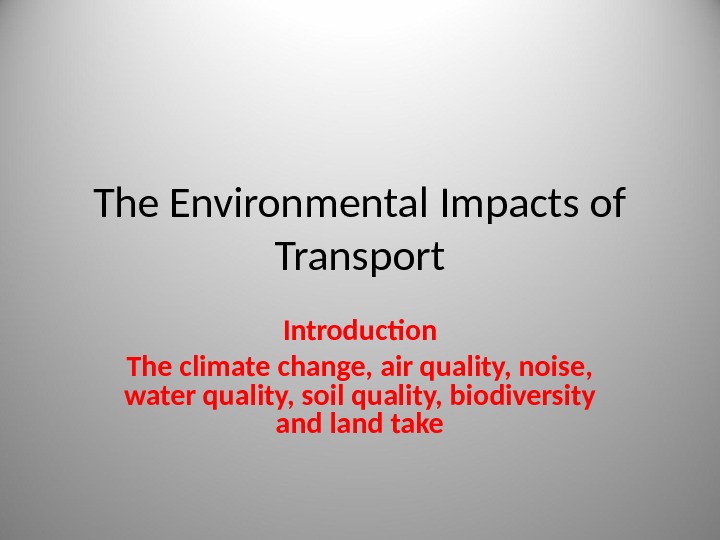
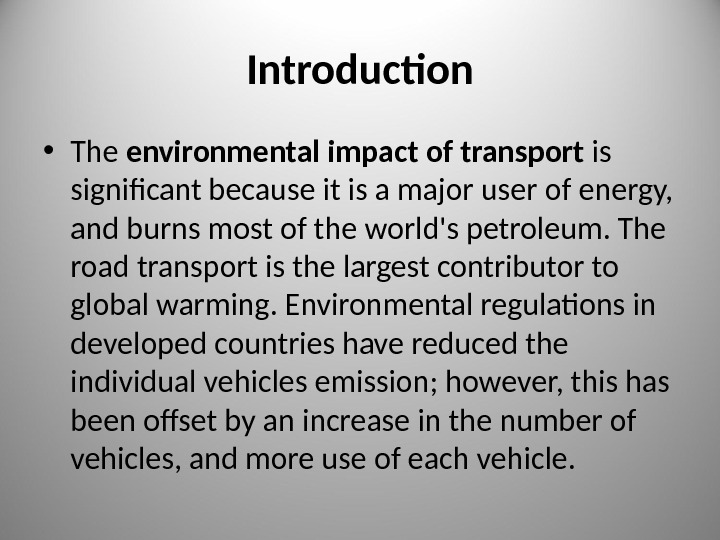
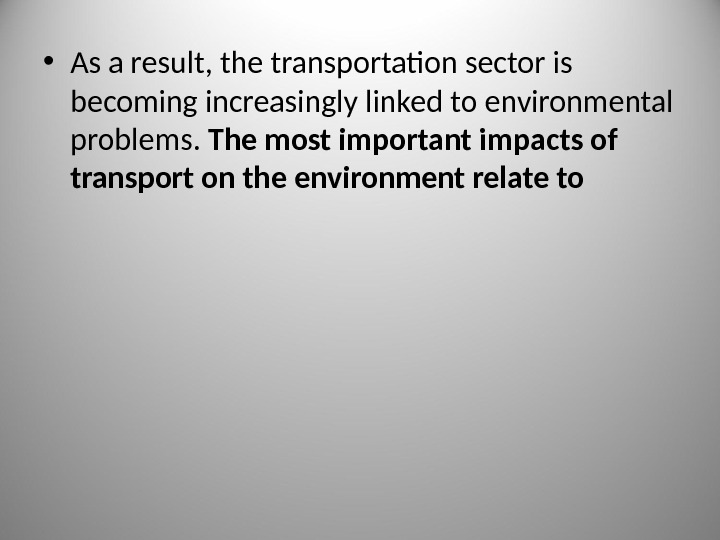
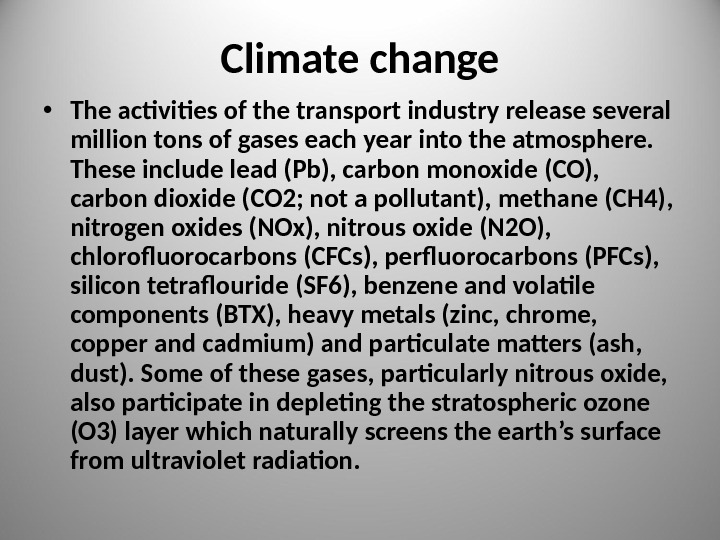

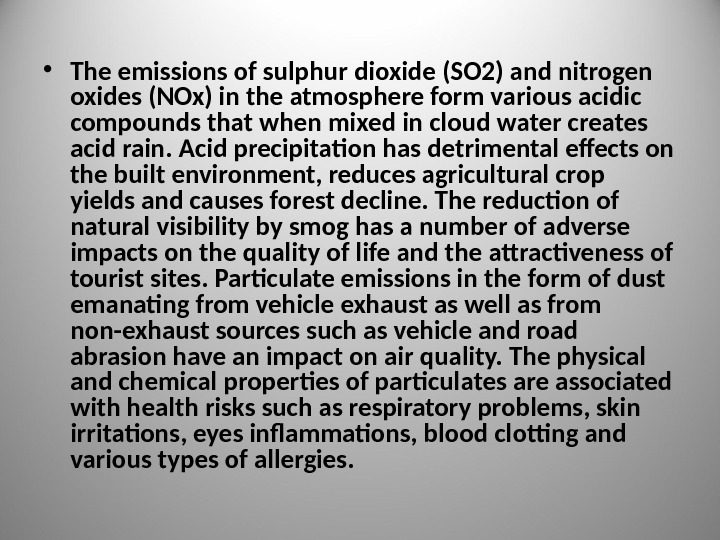
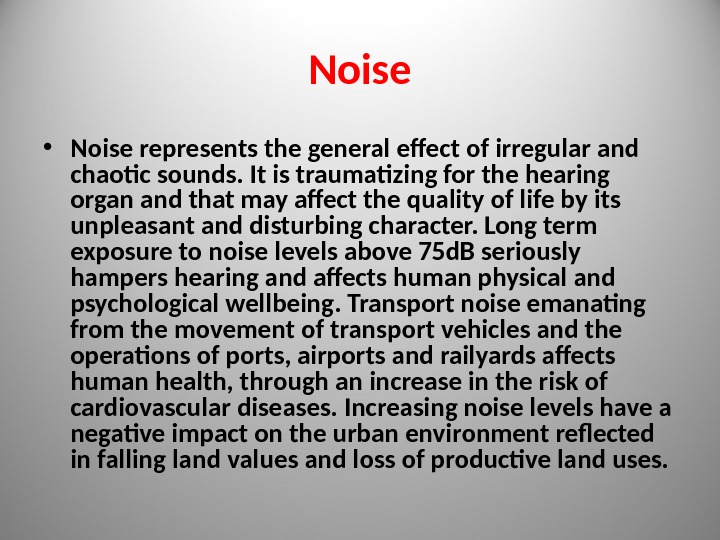
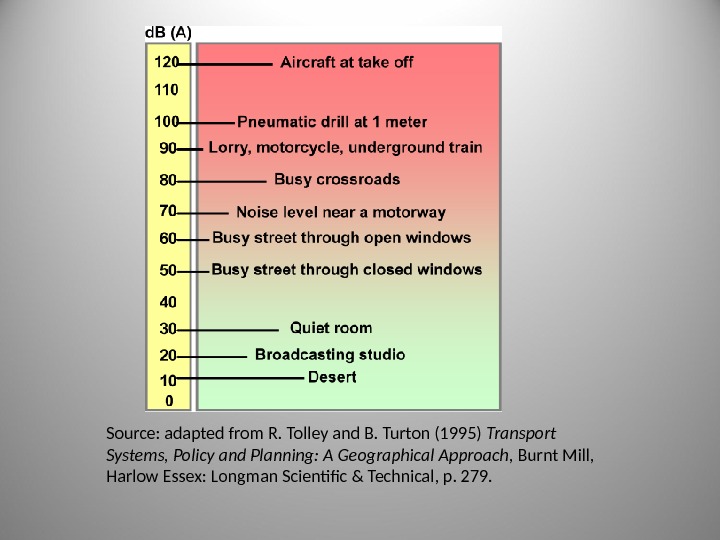
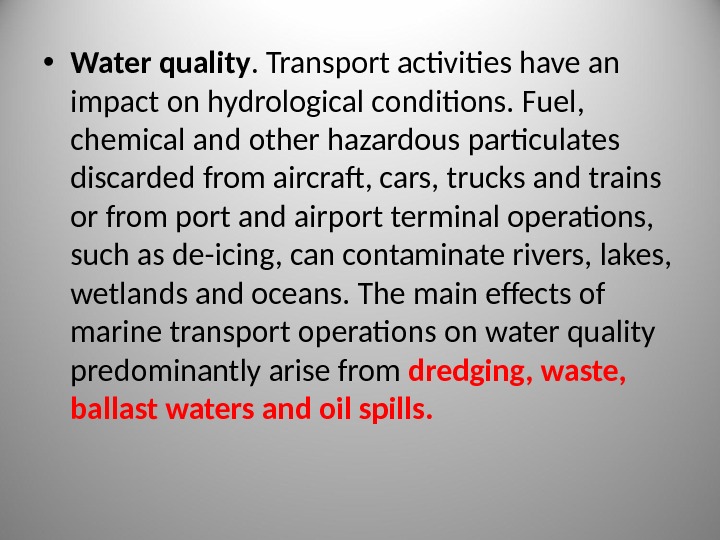

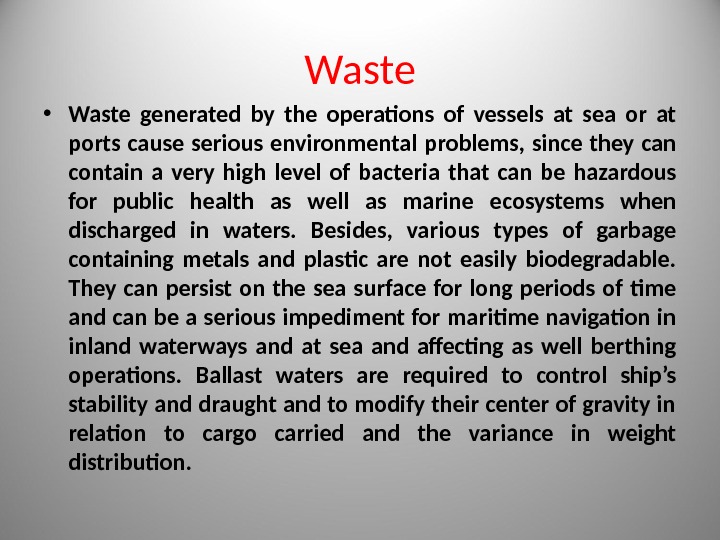
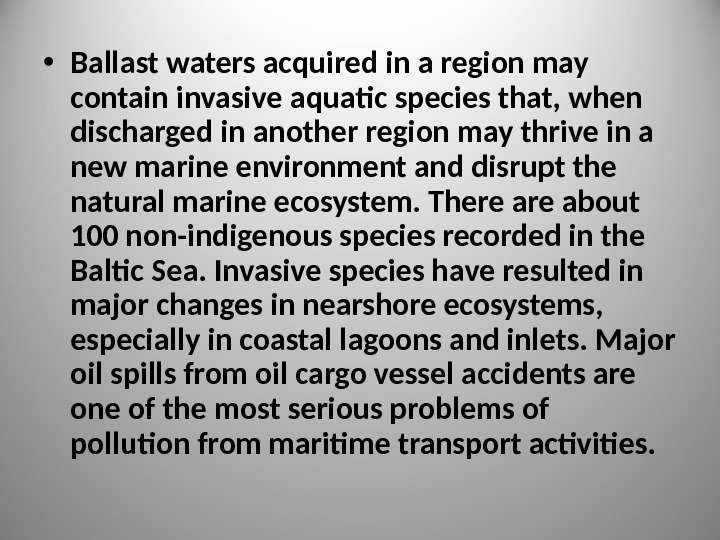
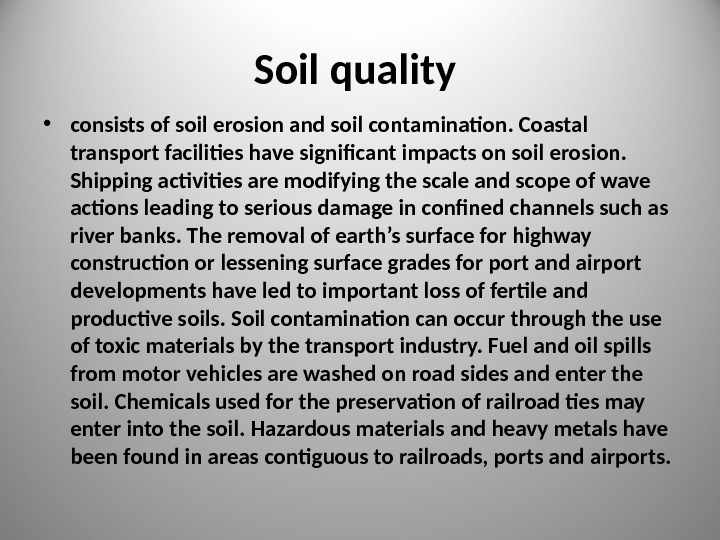
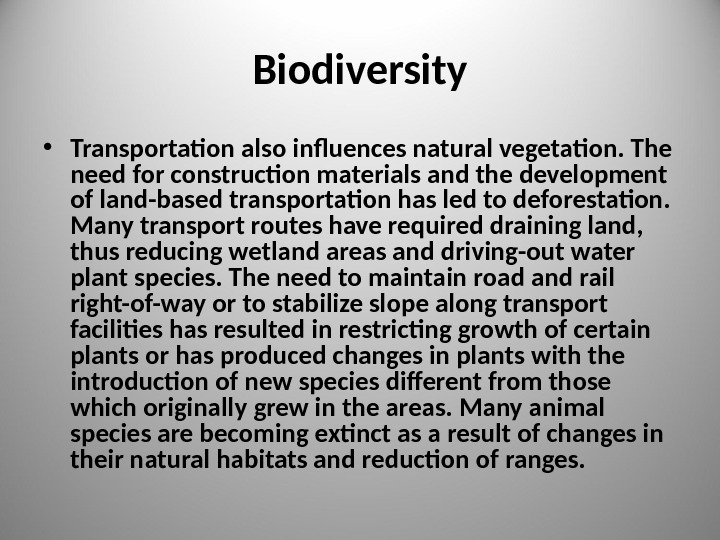
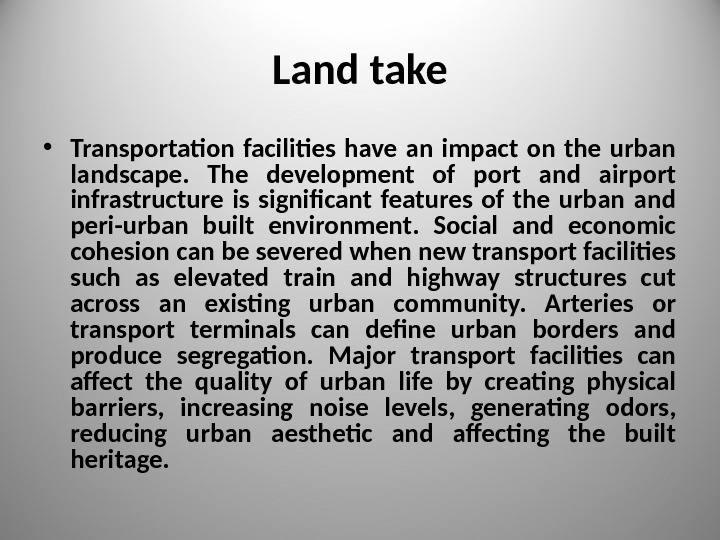
- Размер: 245.5 Кб
- Количество слайдов: 15
Описание презентации Презентация trans imp по слайдам
 The Environmental Impacts of Transport Introduction The climate change, air quality, noise, water quality, soil quality, biodiversity and land take
The Environmental Impacts of Transport Introduction The climate change, air quality, noise, water quality, soil quality, biodiversity and land take
 Introduction • The environmental impact of transport is significant because it is a major user of energy, and burns most of the world’s petroleum. The road transport is the largest contributor to global warming. Environmental regulations in developed countries have reduced the individual vehicles emission; however, this has been offset by an increase in the number of vehicles, and more use of each vehicle.
Introduction • The environmental impact of transport is significant because it is a major user of energy, and burns most of the world’s petroleum. The road transport is the largest contributor to global warming. Environmental regulations in developed countries have reduced the individual vehicles emission; however, this has been offset by an increase in the number of vehicles, and more use of each vehicle.
 • As a result, the transportation sector is becoming increasingly linked to environmental problems. The most important impacts of transport on the environment relate to
• As a result, the transportation sector is becoming increasingly linked to environmental problems. The most important impacts of transport on the environment relate to
 Climate change • The activities of the transport industry release several million tons of gases each year into the atmosphere. These include lead (Pb), carbon monoxide (CO), carbon dioxide (CO 2; not a pollutant), methane (CH 4), nitrogen oxides (NOx), nitrous oxide (N 2 O), chlorofluorocarbons (CFCs), perfluorocarbons (PFCs), silicon tetraflouride (SF 6), benzene and volatile components (BTX), heavy metals (zinc, chrome, copper and cadmium) and particulate matters (ash, dust). Some of these gases, particularly nitrous oxide, also participate in depleting the stratospheric ozone (O 3) layer which naturally screens the earth’s surface from ultraviolet radiation.
Climate change • The activities of the transport industry release several million tons of gases each year into the atmosphere. These include lead (Pb), carbon monoxide (CO), carbon dioxide (CO 2; not a pollutant), methane (CH 4), nitrogen oxides (NOx), nitrous oxide (N 2 O), chlorofluorocarbons (CFCs), perfluorocarbons (PFCs), silicon tetraflouride (SF 6), benzene and volatile components (BTX), heavy metals (zinc, chrome, copper and cadmium) and particulate matters (ash, dust). Some of these gases, particularly nitrous oxide, also participate in depleting the stratospheric ozone (O 3) layer which naturally screens the earth’s surface from ultraviolet radiation.
 Air quality • Highway vehicles, marine engines, locomotives and aircraft are the sources of pollution in the form of gas and particulate matters emissions that affects air quality causing damage to human health. Toxic air pollutants are associated with cancer, cardiovascular, respiratory and neurological diseases. Carbon monoxide (CO) when inhale affects bloodstream, reduces the availability of oxygen and can be extremely harmful to public health. An emission of nitrogen dioxide (NO 2) from transportation sources reduces lung function, affects the respiratory immune defense system and increases the risk of respiratory problems.
Air quality • Highway vehicles, marine engines, locomotives and aircraft are the sources of pollution in the form of gas and particulate matters emissions that affects air quality causing damage to human health. Toxic air pollutants are associated with cancer, cardiovascular, respiratory and neurological diseases. Carbon monoxide (CO) when inhale affects bloodstream, reduces the availability of oxygen and can be extremely harmful to public health. An emission of nitrogen dioxide (NO 2) from transportation sources reduces lung function, affects the respiratory immune defense system and increases the risk of respiratory problems.
 • The emissions of sulphur dioxide (SO 2) and nitrogen oxides (NOx) in the atmosphere form various acidic compounds that when mixed in cloud water creates acid rain. Acid precipitation has detrimental effects on the built environment, reduces agricultural crop yields and causes forest decline. The reduction of natural visibility by smog has a number of adverse impacts on the quality of life and the attractiveness of tourist sites. Particulate emissions in the form of dust emanating from vehicle exhaust as well as from non-exhaust sources such as vehicle and road abrasion have an impact on air quality. The physical and chemical properties of particulates are associated with health risks such as respiratory problems, skin irritations, eyes inflammations, blood clotting and various types of allergies.
• The emissions of sulphur dioxide (SO 2) and nitrogen oxides (NOx) in the atmosphere form various acidic compounds that when mixed in cloud water creates acid rain. Acid precipitation has detrimental effects on the built environment, reduces agricultural crop yields and causes forest decline. The reduction of natural visibility by smog has a number of adverse impacts on the quality of life and the attractiveness of tourist sites. Particulate emissions in the form of dust emanating from vehicle exhaust as well as from non-exhaust sources such as vehicle and road abrasion have an impact on air quality. The physical and chemical properties of particulates are associated with health risks such as respiratory problems, skin irritations, eyes inflammations, blood clotting and various types of allergies.
 Noise • Noise represents the general effect of irregular and chaotic sounds. It is traumatizing for the hearing organ and that may affect the quality of life by its unpleasant and disturbing character. Long term exposure to noise levels above 75 d. B seriously hampers hearing and affects human physical and psychological wellbeing. Transport noise emanating from the movement of transport vehicles and the operations of ports, airports and railyards affects human health, through an increase in the risk of cardiovascular diseases. Increasing noise levels have a negative impact on the urban environment reflected in falling land values and loss of productive land uses.
Noise • Noise represents the general effect of irregular and chaotic sounds. It is traumatizing for the hearing organ and that may affect the quality of life by its unpleasant and disturbing character. Long term exposure to noise levels above 75 d. B seriously hampers hearing and affects human physical and psychological wellbeing. Transport noise emanating from the movement of transport vehicles and the operations of ports, airports and railyards affects human health, through an increase in the risk of cardiovascular diseases. Increasing noise levels have a negative impact on the urban environment reflected in falling land values and loss of productive land uses.
 Source: adapted from R. Tolley and B. Turton (1995) Transport Systems, Policy and Planning: A Geographical Approach , Burnt Mill, Harlow Essex: Longman Scientific & Technical, p. 279.
Source: adapted from R. Tolley and B. Turton (1995) Transport Systems, Policy and Planning: A Geographical Approach , Burnt Mill, Harlow Essex: Longman Scientific & Technical, p. 279.
 • Water quality. Transport activities have an impact on hydrological conditions. Fuel, chemical and other hazardous particulates discarded from aircraft, cars, trucks and trains or from port and airport terminal operations, such as de-icing, can contaminate rivers, lakes, wetlands and oceans. The main effects of marine transport operations on water quality predominantly arise from dredging, waste, ballast waters and oil spills.
• Water quality. Transport activities have an impact on hydrological conditions. Fuel, chemical and other hazardous particulates discarded from aircraft, cars, trucks and trains or from port and airport terminal operations, such as de-icing, can contaminate rivers, lakes, wetlands and oceans. The main effects of marine transport operations on water quality predominantly arise from dredging, waste, ballast waters and oil spills.
 Dredging • Dredging is the process of deepening harbor channels by removing sediments from the bed of a body of water. Dredging is essential to create and maintain sufficient water depth for shipping operations and port accessibility. Dredging activities have a two-fold negative impact on the marine environment. They modify the hydrology by creating turbidity that can affect the marine biological diversity. The contaminated sediments and water raised by dredging require spoil disposal sites and decontamination techniques.
Dredging • Dredging is the process of deepening harbor channels by removing sediments from the bed of a body of water. Dredging is essential to create and maintain sufficient water depth for shipping operations and port accessibility. Dredging activities have a two-fold negative impact on the marine environment. They modify the hydrology by creating turbidity that can affect the marine biological diversity. The contaminated sediments and water raised by dredging require spoil disposal sites and decontamination techniques.
 Waste • Waste generated by the operations of vessels at sea or at ports cause serious environmental problems, since they can contain a very high level of bacteria that can be hazardous for public health as well as marine ecosystems when discharged in waters. Besides, various types of garbage containing metals and plastic are not easily biodegradable. They can persist on the sea surface for long periods of time and can be a serious impediment for maritime navigation in inland waterways and at sea and affecting as well berthing operations. Ballast waters are required to control ship’s stability and draught and to modify their center of gravity in relation to cargo carried and the variance in weight distribution.
Waste • Waste generated by the operations of vessels at sea or at ports cause serious environmental problems, since they can contain a very high level of bacteria that can be hazardous for public health as well as marine ecosystems when discharged in waters. Besides, various types of garbage containing metals and plastic are not easily biodegradable. They can persist on the sea surface for long periods of time and can be a serious impediment for maritime navigation in inland waterways and at sea and affecting as well berthing operations. Ballast waters are required to control ship’s stability and draught and to modify their center of gravity in relation to cargo carried and the variance in weight distribution.
 • Ballast waters acquired in a region may contain invasive aquatic species that, when discharged in another region may thrive in a new marine environment and disrupt the natural marine ecosystem. There about 100 non-indigenous species recorded in the Baltic Sea. Invasive species have resulted in major changes in nearshore ecosystems, especially in coastal lagoons and inlets. Major oil spills from oil cargo vessel accidents are one of the most serious problems of pollution from maritime transport activities.
• Ballast waters acquired in a region may contain invasive aquatic species that, when discharged in another region may thrive in a new marine environment and disrupt the natural marine ecosystem. There about 100 non-indigenous species recorded in the Baltic Sea. Invasive species have resulted in major changes in nearshore ecosystems, especially in coastal lagoons and inlets. Major oil spills from oil cargo vessel accidents are one of the most serious problems of pollution from maritime transport activities.
 Soil quality • consists of soil erosion and soil contamination. Coastal transport facilities have significant impacts on soil erosion. Shipping activities are modifying the scale and scope of wave actions leading to serious damage in confined channels such as river banks. The removal of earth’s surface for highway construction or lessening surface grades for port and airport developments have led to important loss of fertile and productive soils. Soil contamination can occur through the use of toxic materials by the transport industry. Fuel and oil spills from motor vehicles are washed on road sides and enter the soil. Chemicals used for the preservation of railroad ties may enter into the soil. Hazardous materials and heavy metals have been found in areas contiguous to railroads, ports and airports.
Soil quality • consists of soil erosion and soil contamination. Coastal transport facilities have significant impacts on soil erosion. Shipping activities are modifying the scale and scope of wave actions leading to serious damage in confined channels such as river banks. The removal of earth’s surface for highway construction or lessening surface grades for port and airport developments have led to important loss of fertile and productive soils. Soil contamination can occur through the use of toxic materials by the transport industry. Fuel and oil spills from motor vehicles are washed on road sides and enter the soil. Chemicals used for the preservation of railroad ties may enter into the soil. Hazardous materials and heavy metals have been found in areas contiguous to railroads, ports and airports.
 Biodiversity • Transportation also influences natural vegetation. The need for construction materials and the development of land-based transportation has led to deforestation. Many transport routes have required draining land, thus reducing wetland areas and driving-out water plant species. The need to maintain road and rail right-of-way or to stabilize slope along transport facilities has resulted in restricting growth of certain plants or has produced changes in plants with the introduction of new species different from those which originally grew in the areas. Many animal species are becoming extinct as a result of changes in their natural habitats and reduction of ranges.
Biodiversity • Transportation also influences natural vegetation. The need for construction materials and the development of land-based transportation has led to deforestation. Many transport routes have required draining land, thus reducing wetland areas and driving-out water plant species. The need to maintain road and rail right-of-way or to stabilize slope along transport facilities has resulted in restricting growth of certain plants or has produced changes in plants with the introduction of new species different from those which originally grew in the areas. Many animal species are becoming extinct as a result of changes in their natural habitats and reduction of ranges.
 Land take • Transportation facilities have an impact on the urban landscape. The development of port and airport infrastructure is significant features of the urban and peri-urban built environment. Social and economic cohesion can be severed when new transport facilities such as elevated train and highway structures cut across an existing urban community. Arteries or transport terminals can define urban borders and produce segregation. Major transport facilities can affect the quality of urban life by creating physical barriers, increasing noise levels, generating odors, reducing urban aesthetic and affecting the built heritage.
Land take • Transportation facilities have an impact on the urban landscape. The development of port and airport infrastructure is significant features of the urban and peri-urban built environment. Social and economic cohesion can be severed when new transport facilities such as elevated train and highway structures cut across an existing urban community. Arteries or transport terminals can define urban borders and produce segregation. Major transport facilities can affect the quality of urban life by creating physical barriers, increasing noise levels, generating odors, reducing urban aesthetic and affecting the built heritage.
